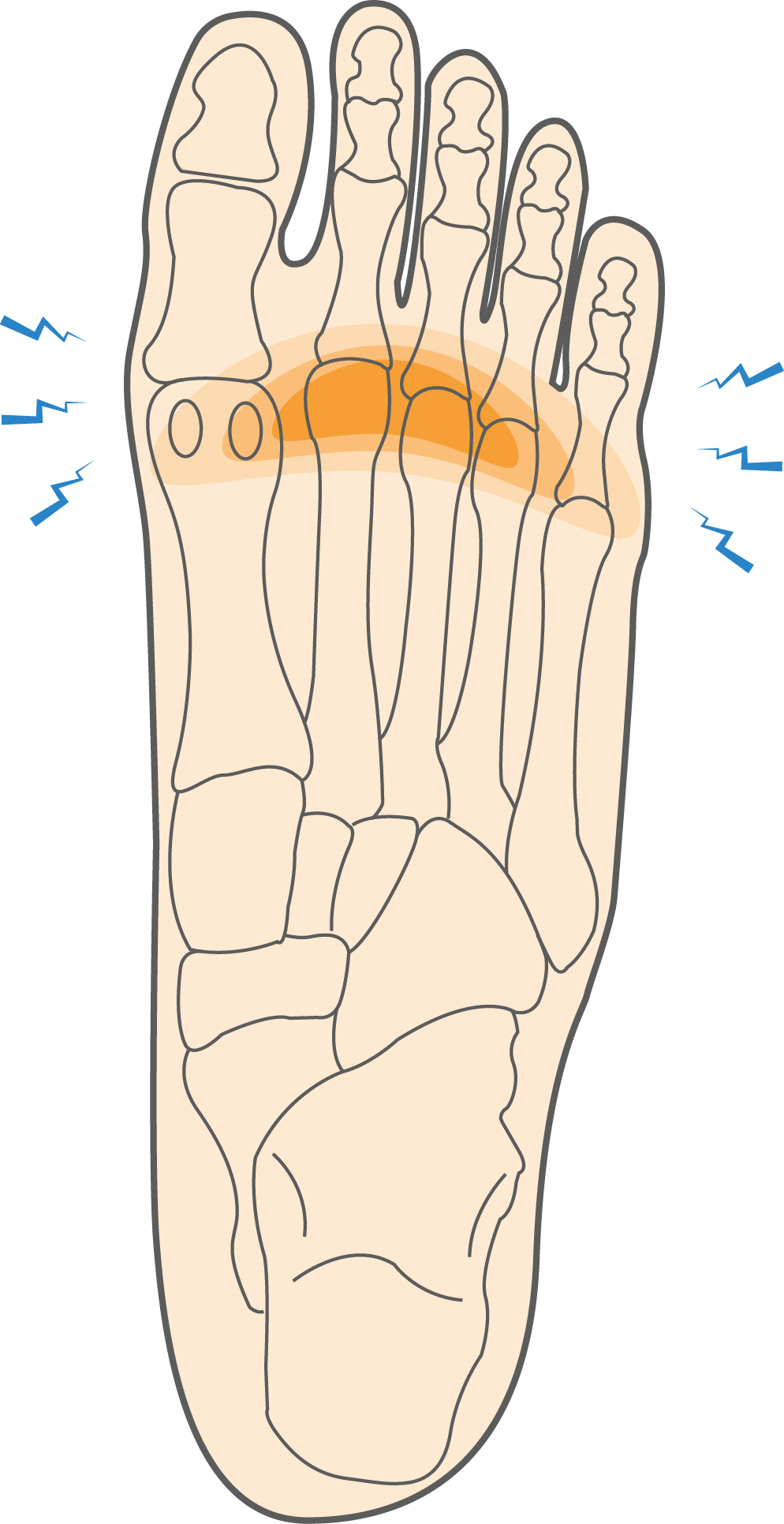Metatarsalgia is a term for pain and inflammation of the ball of the foot. The condition is especially common among athletes who play high-impact sports due to the stress they place on the balls of their feet when running and jumping. While not considered a serious injury, a sore foot and other symptoms associated with metatarsalgia can keep you from being active and playing the sports you enjoy.
Metatarsalgia Causes, Symptoms & Treatment Options
Metatarsalgia is a term for ball-of-foot pain and inflammation. The condition is especially common among athletes who play high-impact sports due to the stress they place on the balls of their feet when running and jumping.
Overview
Overview

What causes Metatarsalgia?
Metatarsalgia is common among athletes, often caused by the repeated stress they place on the balls of their feet during exercise or play. But other factors can also cause this injury. Weak or tight muscles, such as the tightness of the Achilles tendon, can contribute to metatarsalgia. Deformities of the foot, such as hammer toe (which causes your toe to curl downward), can also lead to this injury. Other contributing factors to metatarsalgia include ill-fitting shoes and using poor form during play. In some cases, conditions like Morton’s neuroma can overlap with or exacerbate metatarsalgia symptoms.
Metatarsalgia is most common in these sports:
• Running
• Basketball
• Soccer
• Rugby
• Lacrosse
• Field Hockey
Symptoms
Metatarsalgia is typically marked by ball-of-foot pain. Pain often gets worse when standing, running, or walking barefoot. Other common symptoms include:
- Pain is characterized as sharp, burning, or aching
- Feeling like you have a pebble in your shoe
- Pain, numbness, or tingling in your toes
- Pain that develops gradually over several weeks rather than suddenly
- Signs of forefoot overload from repetitive impact
When to see a doctor
If your foot pain lasts for more than a few weeks, you should get it checked by your doctor. Left untreated, metatarsalgia can create other problems in your foot or your hips if your gait is affected. Your doctor will take a medical history and conduct a physical examination during your visit. This will include examining the area around your toes and the ball of your foot, looking for signs of tenderness. Your doctor will also examine your entire lower leg, looking for toe flexor tightness or muscle imbalances that can lead to metatarsalgia. He/She may also ask questions about the sports you play and check how your shoes fit, especially if ill-fitting shoes are suspected. To help confirm the diagnosis and exclude other causes of your symptoms (such as a stress fracture), x-rays and other imaging tests may be ordered.
Non-operative treatment
Metatarsalgia is generally treated conservatively. To give your foot time to heal, it’s important to take a break from activities that cause pain in your foot. Common treatments also include:
• Applying ice and elevating your foot to relieve pain
• Using crutches if walking is painful
• Wearing properly fitting shoes
• Using metatarsal pads to absorb pressure on the ball of your foot
• Inserting arch supports into your shoes for support and structure
• Anti-inflammatory medication for pain relief
Try these exercises to help address your condition:
Below is a PDF of the Exercise Program
Surgical Treatment
Surgery is rarely recommended for metatarsalgia. In very rare cases, surgical realignment of the metatarsal bones in your foot may be needed to address your metatarsalgia.
Recovery
Recovery from metatarsalgia can range from a few days to several weeks, depending on the extent of your injury. Other factors can influence your recovery time, including your age, weight, and the overall condition of your foot. Your doctor will help guide you on your return to normal activities.
GET BACK TO WHAT YOU LOVE. FASTER
Sources
https://www.ipfh.org/foot-conditions/foot-conditions-a-z/metatarsalgia?gclid=Cj0KCQjw_vfcBRDJARIsAJafEnEo74E4AcnPxq5aHdxgbKFon4jrmsCQAE5_TsMpAYVsuzTEfMK6I3QaAnTiEALw_wcB
https://www.mayoclinic.org/diseases-conditions/metatarsalgia/symptoms-causes/syc-20354790
https://viewmedica.com/vm/index/brochure/68/metatarsalgia/en
https://www.summitmedicalgroup.com/library/adult_health/sma_metatarsalgia/
Frequently Asked Questions
Can I stay active with metatarsalgia?
Yes! Most people can continue light activities with proper footwear, rest, and support like metatarsal pads and eventually return to activities without restrictions.
Do I need surgery for metatarsalgia?
In most cases, no. Conservative treatments like shoe inserts, physical therapy, and rest are highly effective for relieving symptoms.
How long does recovery take?
Many people feel better within a few weeks of starting treatment. With consistency and care, you can expect a steady and safe return to your routine.
What can I do to prevent it from coming back?
Wearing well-fitting shoes, using arch support, and avoiding overuse in high-impact sports are simple steps that help prevent recurrence.

